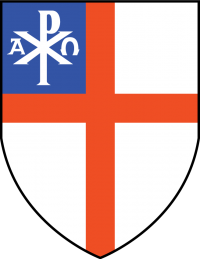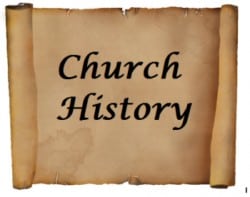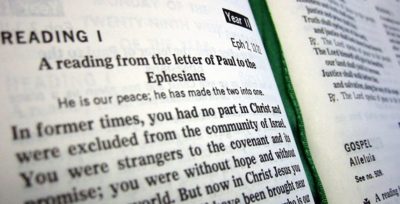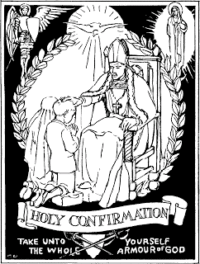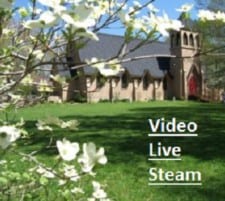Nature of Anglicanism: notes for Wed. Oct 24th 2018
We finished the Sacraments last week…
Scripture and the Anglican Faith:
Apostolic Succession, the Creeds, and the development of the Canon of Scripture help to combat heresies.
The spokesmen of the Church and thus early church doctrine were the Apostles and those they appointed, Acts 6, and the emphasis placed upon them can be seen as early as late the first century by early Church fathers such as Clement of Rome. The emphasis placed upon the early Bishops allowed them to battle heresy within the church. Their authority came from the Apostles thus there words and doctrine had much weight over those of the different heresy’s and the source of their origin and development.
The Creeds were developed and instituted to battle the heresy’s of their time (Nicaea – Arianism) and to lay out the basics of the Christian Faith. They were formed by the Church speaking as one voice (although there were disagreements within the delegation) and allowed the Christian faith to be defined by the words of the creeds.
By Canonizing the Scripture, the Christian Faith was able to state the only books from which its doctrines were to be derived. This help the Church defend against the different writings that the heretical church would use to back their doctrine. In a way it helped narrow the resources needed to combat false teachings and false practices which tried to gain footing in the early church.
The Bible’s Place in Anglican Theology:
The very first question we want to address is where Holy Scripture sits in our doctrine. This is answered by saying that Scripture is the first and foundational of three factors that make up our theology; the other two are Christian tradition and reason.
For Anglicans, the Bible is authoritative for Christian belief because the Church of today is “in continuity with Israel and the early Church. This community’s classic and normative experience of Jesus and God in the history of Israel (as revealed in the Bible) still gives our faith its basic shape today.”
Christian tradition is the record of the church’s efforts to understand and convey the faith of the Bible.
The Bible is the Church’s “account of Jesus and of Israel’s experience of God. It is also the standard against which extensions must be tested. Reason is the construction of reality in which our biblical faith can be understood. Scripture, Tradition, and Reason are required to produce a theology adequate to meet Anglican standards.
Having identified the Bible as the first essential component of our Anglican theology, we will expand upon its authority from five perspectives:
(1) Canon of Scripture as the Word of God;
(2) as inspired by God;
(3) as sufficient for leading us to salvation and nurturing our awareness of God;
(4) as the primary source document of our faith; and as canon within the Anglican Church.
(5) It is through these perspectives that we should see that the Bible truly serves as the anchor and guiding light of our faith. We will also take a look at the interpretation of scripture.
THE AUTHORITY OF SCRIPTURE IN ANGLICAN THEOLOGY:
- Canon of Scripture as the Word of God
Canon of Holy Scripture is defined as the collection of inspired writings, made by the tradition and authority of the Church, which contain the rule of Divine Faith. Canonical therefore means accepted or recognized by the Church. The principle that only the Church has the right to declare a Book canonical is recognized by the Roman Catholic Church, the Orthodox Churches, and the Anglican Communion. The Jews seem to be the first people to have had authoritative scriptures and the council of Jamnia in A.D 70 gave the Jewish Canon its final form. Early Christian writers, such as Justin Martyr, were referring to the New Testament as contrasted with the Old Testament and insisted that both be treated with equal authority. It was not until 367 when Athanasius circulated his thirty-ninth Festal Letter which identifies the twenty seven books of the New Testament, as we now know it, as being canonical.
Finally we find the New Testament fixed by the Council of Carthage (397.) Its formation had to resolve the East and West Church views on which books were valid. An example is shown as the West had concern for the Book of Hebrews and the East had concern about the book Revelation (there were other books of concern as well.) The order of the books had to also be established. As well they had to establish which books would not be included (first letter of Clement as well as the Didache.) For a book to become Holy Scripture it had to enjoy widespread acceptance among the churches – regional acceptance was not enough.
- Scripture as Inspired by God:
The notion that Scripture is inspired by God is a belief inherited by the Christian Church from Judaism. While some have interpreted this to mean that God “guided the pens of the human writers or dictated his words to their minds,” more indirectly it is viewed that God was the ultimate, not the immediate, cause behind the writing of Scripture. While it was human beings who wrote the Bible, God was the primary cause of its being written and revealed what was required.
Some Anglican scholars have argued recently for the abandonment of the doctrine of inspiration, essentially because it is often associated with the notion of inerrancy. Others argue, however, that it should be retained. First, the BCP says that the Old and New Testaments were “written under the inspiration of the Holy Spirit.” A sacramental understanding of the Bible as the word of God seems to require the doctrine of inspiration…in the sense that the human words proclaim the Christ event with the power to evoke faith. To produce faith is precisely the work of the Holy Spirit.”
We share the doctrine of inspiration in our ecumenical dialogue with the Roman Catholic and Orthodox Churches, of which affirm the doctrine. This is important because it evidences our relationship with and commitment to the larger Church.
Next, let us consider the sufficiency of Scripture. Here the question is whether the Bible adequately contains what is necessary for obtaining salvation in Jesus Christ.
In the Anglican view, the Bible does contain all that is necessary for us to obtain salvation. Article VI of the Thirty Nine Articles states explicitly: “Holy Scripture containeth all things necessary to salvation…” Fuller says has stated “No other book, however primitive or inspiring, can add anything to the witness of these acts of God, however much it may contribute to our understanding of them. This is because the saving acts of God took place once-for-all, and with the events there is also a once-for-all authoritative witness. This witness is the work either of those who had themselves directly witnessed those events…or of those who were in immediate contact with that witness, who…were “so completely created by apostolic witness and formed by apostolic obedience that they are veritably carried across into the company of the original disciples of Jesus and invested with the authority of their mission.”
- The Primacy of Scripture
When talking about the primacy of Scripture, what we mean is that Holy Scripture is the norm of our faith; it is the norm by which the other norms of our Church (the creeds, tradition, confessions of faith.) Theological propositions have only secondary importance and represent the attempt of the faith to understand itself.
- The Bible as Canon
Closely associated with the idea of Scripture as the norm of our faith is the idea of the canon: the list of books recognized as belonging to the normative writings of our faith. For Anglicans, all books of the New Testament are canonical and the Old Testament books of the Hebrew Bible are considered canonical. The additional books of the Greek Bible, called the Apocrypha, are valued and used in our modern day lectionaries. However, they occupy a secondary position in our theology and amplify rather than establish doctrine.
It is interesting to see how the New Testament canon has informed and shaped all Christian theology including our own Anglican theology. The structure of the New Testament canon is first, the Gospels, followed by Acts, then the Epistolary writings, and finally, Revelation. “The fact that four Gospels come first means that the incarnation together with the Trinity is, for Anglicanism, fundamental to the faith (and this …involves faith in the God of the Old Testament, which precedes the New Testament in the canon). The structure of the Thirty-Nine Articles reflects this pattern, for the Articles begin with the Trinity and the incarnation.” Paul’s letters to the Colossians and Ephesians place the doctrine of salvation in an “ecclesial perspective”: “The Colossian-Ephesian doctrine of the Church as the Body of Christ of which he is the head is of particular significance to Anglicanism.”
Other examples of where the Bible as canon has informed our Church doctrine include the Letter to the Hebrews, which has played a long and essential role in our theology, especially in the doctrine of the Eucharist. “It was Hebrews’ insistence on the once-for-all character of Christ’s sacrifice that gave Cramner the warrant for his exortium to the Prayer of Consecration in the Communion Service of 1549 &1552: ‘…who made there (by his one oblation of himself once offered) a full, perfect, and sufficient sacrifice, oblation, and satisfaction, for the sins of the whole world.’ This emphasis is repeated in Article XXXI.
PART II: BIBLICAL INTERPRETATION:
The text of the Bible itself is a response to fundamental encounters with the living God, and it is to this living God that the text bears witness. Through a process of interpretation, and ongoing encounters with this living God, the Bible took on its present form. And this whole is greater than the sum of its parts, enabling these words to address the human spirit in all its diverse cultural and personal expressions.
As Anglicans, we share this attentiveness to the words of Scripture, and this reverence for the God who speaks in Scripture. We also share a reverence for tradition, the ongoing history of the reception of this word.
Rabbinic Interpreters
The older brother of the Church, the synagogue, had a profound reverence for the vitality of the word of the God who spoke—of the God who speaks in Scripture. Each Sabbath, in the setting of confession of faith, prayer, and praise, Scripture was read and heard—and interpreted to the worshippers. For the devout, there were other gatherings for the study and interpretation of Scripture. This study and interpretation was carried out in the context of the life of the community.
The Early Church
The path that led to modern Christianity was laid out by teachers whose interpretation began with the crucifixion and resurrection of the Messiah. Their treatment of Scripture bound the story of the crucified one into the ancient stories of God’s works among the people of God. At every point, in a variety of ways, they established connections between the words and stories in the Law and the Prophets and the new stories of the crucified one. Paul engages the discussion of the specific qualities of a righteous life in the light of the stories of the crucified one.
The proclamation of Christ crucified was the proclamation of a theology of grace that made reconciliation with God the starting point, and not the result, of our efforts to be righteous. In the process, the plain meaning of the text was dramatically transformed. In the light of this proclamation, the story of the Jerusalem Council in Acts abolishes observances of the Torah that are fundamental to widespread definitions of righteousness according to the Torah. The Gospels bring together the words and sayings of Jesus, in close dialogue with the stories in the Law and the Prophets, as new stories in the history of the work of God in the history of the people of God. In the light of this new proclamation of the risen Messiah, subtle themes in the book of Isaiah—the God who comes as a healer and the suffering servant who will come—become the foundation for a substantial rereading of Scripture.
Church Fathers: brief contributions to Christianity of the following:
- Polycarp, A.D. 69-157
A defender of orthodoxy and he devoted much of his energy to combating the heresy’s of his day. His long life allowed him to be a bridge between the Apostolic Age and the great Christian writers of the late 2nd century. His death is legendary as upon his return Smyrna he was burned to death because he refused to recant his faith in which he had served Christ for 86 years
- Ignatius, A.D. 67-110
Bishop of Antioch, either second (Origen) or third (Eusebius). Little is known of his life but his journey to martyrdom from Antioch to Rome under the guard of ten soldiers is famous. He begged his followers in the Churches of Ephesus, Manesia, and Tralles, and the Church of Rome during his route to his death not to deprive him of martyrdom by intervention with the pagan authorities. His faith unto death served as an example and motivation for others to follow Christ.
- Papias, A.D. 70-155
A disciple of John and companion of Polycarp. Of his theology we know that he held the view of a Millenarian – a thousand years after the Resurrection during which the Kingdom of Christ would be set up on earth in a material form. As well, from my memory, he also had a raw and primitive view of the Trinity although it varied from what we believe today.
- Justin Martyr, A.D. 100-167
Early Christian apologist. His doctrine of the Logos was used to explain why Christiians, while remaining monotheists, worshipped Jesus Christ, regarding him as an incarnation of the Logos. Of note, his apologetical work included a summary of the early Mass of the Church which reflects a Eucharist in which we as people of orthodoxy we would be comfortable. As well he recognized a “three-ness” of God. As we today, he had a general view that Baptism brings a forgiveness of sin.
- Irenaeus, A.D. 130-200
His thought and life formed a link between East and Western churches. His life was in the time when Gnosticism was a serious threat to the Church and his writings often reflect an attack on Gnosticism by emphasizing the traditional elements of the Church, especially the episcopate, scripture from OT and NT, and theological tradition.
- Origen, A.D. 185-220
Born to Christian family – a child genius who burned with love for Christianity. When his father was martyred Origen told him to not weaken – do not deny Christ! When he was 18 yrs old he became the leader of the Alexandrian school and his fame begin to spread. He defended the church from Marcionites as he viewed scripture in a literal, moral, and allegorical manner of which he relied heavily on allegorical interpretation. He also affirms the threefold nature of the godhead. In his “Treatise on Prayer” he emphasizes prayer be to the Father through the Son. He also taught a strong belief in “Free Will” plays a role in determining the souls final destination.
- Tertullian, A.D. 160-220
First apologist to use the word Trinity and taught that while there are three persons they are distinct but not divided and are of the same substance (one being, three persons.) He emphasized a separation from pagan society, which was necessary in order to escape contamination from its immorality and idolatry. He disposes of all heresy in principle: the one true Church, visible in history through the episcopal succession alone possesses the authentic tradition from Christ and the apostles, and alone has authority to interpret Scripture. He did not like Infant Baptism and because of its asceticism he was drawn towards Montanism and its emphases upon the immediacy of the Spirit (Paraclete) and ecstatic prophecy (this is discussed later.)
Christians persecutions: by the Roman government
The secrecy of the early Christians rites (which they did out of fear) and misunderstandings of “Christian” language (Jn 6:35 – Bread of Life) and the confusion concerning the Agape (as carnal love as compared with spiritual love) and the Eucharist led pagans to suppose them guilty of promiscuity, incest, cannibalism, as well as being atheist (refused the Roman Gods.) From the practical side, the Christians could be blamed for bad things that happened – they were good scapegoats to be blamed falsely, as Christ said they would be treated.
False doctrines arose; even in the days of the Apostles. Brief description of:
- Ceremonialism (Hebrews)
The Priesthood of Christ presupposes the Priest of the Temple and synagogue. The ceremonies of the Temple (which were temporary) have been replaced by the Priesthood of Christ, the Great High Priest, which is permanent.
- Legalism (Galatians)
There were those teaching that you had to be “Jewish” before you could become a Christian and thus the Laws of the Temple applied (not the laws of God – the Ten Commandments.)
- Asceticism (Colossians)
There were those who were teaching a exercise or training which went beyond the teachings of Christ. Some of the ascetic practices included a renunciation of marriage, home, and property. As well there were extreme forms of fasting and self- deprivation.
- Docetism (I John)
A tendency evolved which considered the humanity and sufferings of the earthly Christ as apparent rather than real. They were teaching that Christ had miraculously escaped the pain of death.
Heresies are nothing new…
Gnosticism, Montanism, and Marcionism.
Gnosticisim – Hellienistic with some Christian ideas – goal was to make universal religion based on the Greek Word Nois – meaning knowledge. Based upon a Supreme Being (The Abyss) which was unapproachable – we cannot define it because “matter” has nothing to do with the Abyss. This Abyss sent forth lesser deities’ which have some divine attributes but with each generation the attributes are less. The Kenoma is the material world (darkness) and the Pleroma is the heavenly realm. The creator God is the Demiurge and Christ was not incarnate. The Gnostics were trying to reconcile evil and good (a main point of Greek writings) – how could evil come from a “good” God. This dividing up of a higher God (Abyss) and lower God (Demiurge – Creator God) which flows from the Pleroma was a way to explain where this evil came from. Through this “gnosis” knowledge was revealed, to some men in which had entered a seed or spark of Divine spiritual substance, this special knowledge of God. Through this “gnosis” one might be rescued from its evil material environment and assured of a return home in the Divine Being. The function of Christ was to come as the emissary of the supreme God bringing “gnosis.”
Montanism – An apocalyptic movement (the End is near / here) in the latter half of the 2nd century. It lived in expectation of the speedy outpouring of the Holy Spirit (the Paraclete) on the Church, of which it saw the first manifestation in its own prophets (Montanus) and prophetesses (Priscilla and Maximiila.) They proclaimed that the Heavenly Jerusalem would soon descend near Pepuza in Phrygia. This movement developed ascetic traits (condemned existing regulations on fasting as being too lax) forbidding second marriages, imposing a strict discipline of its own. Montanus would lose conscience when proclaiming the truth of God – in a state of ecstatic prophecy as he became a mouth piece of God (the orthodox said he was demon possessed as his eyes would roll back in head as he proclaimed Gods words.) Montanism believed in the deity of Christ and believed that the OT gave dispensation of Father, and the NT of the Son and now was the unfolding of the Spirit (Tertullian followed later in his life.)
Marcionism – A very popular heresy founded by Marcion (son of a Bishop- excommunicated by his father who then went to Rome and was excommunicated again – so he founded his own church.) Like the gnostics – a dualism of a Demiurge God (who was harsh and wicked through whom evil entered into world.) Main thrust was that the Christian Gospel was wholly a Gospel of Love to the absolute exclusion of Law. This doctrine led him to reject the OT completely. The Demiurge was wholly a God of Law and it had nothing in common with the God of Jesus Christ. Thus it was Jesus purpose to overthrow the Demiurge.
